London
Foot Hospital
& School of Podiatric Medicine
& School of Podiatric Medicine
33 and 40 Fitzroy Square, W1P 6AY
Medical
dates:
Medical
character:
Specialist (Out-Patients only)
Throughout history, medical and
surgical practitioners rarely paid attention to disorders of the foot
but, by the 18th century, specialisation in the subject began to
develop in France.
In 1845 Lewis Durlacher (1792-1864) tried to establish in London a 'dispensary for the diseases incidental to feet .... for the gratuitous treatment of the needy', (i.e. for those unable to pay). For unknown reasons this project was never realized and it was not until 1913 that a foot hospital came into being.
The chiropodist to Queen Alexandra and Queen Mary, Ernest George Virgo Runting (1861-1954), had been treating the verruca of Dr Arnold Whittaker Oxford (1855-1948). The two men, after some discussion, established the British Chiropodical Society in 1912 and, a year later, the precursor to the London Foot Hospital, the Pedic Clinic.
The Pedic Clinic opened in November 1913 in a 7-roomed cornerhouse at 1-3 Silver Street, Bloomsbury, a dedicatory service being conducted by the Bishop of Willesden. It was the first clinic of its kind in the country; no such institution had previously existed where poor people could be treated for disabling foot disorders. It can be regarded as the birthplace of British chiropody. Clinics were held in the evenings, as the staff needed to make their livings, giving their chiropody service here for free.
The School of Podiatric Medicine was the first to undertake systematic teaching of chiropody. The curriculum contained the subjects of anatomy, pathology, physiology, histology, therapeutics and the chemistry of substances used in chiropody. It was also the first school of chiropody to gain the active support and cooperation of the medical profession. The opening of the School had been delayed by the outbreak of WW1, when staff and potential students had joined the armed services. It finally opened in 1919 and evening courses were held five days a week.
In 1920 the Pedic Clinic moved to 98 Charlotte Street and, in 1924, it was renamed the London Foot Hospital.
In 1929 the Hospital Committee, with the financial assistance of the British Chiropodical Society, managed to acquire the freehold of 33 Fitzroy Square, on the south side of the Square, and the Hospital and School moved there.
During the next decade there was a great expansion of clinical and educational work but, in 1939, war intervened again, placing a physical and financial burden on the Hospital, as staff and students enlisted. In 1940 the southern side of Fitzroy Square was badly damaged by a bomb. Emergency clinics were improvised at the Hospital and the next day patients were treated as usual. Teaching also continued. The stone facade of the terrace was later restored with new office accommodation built behind it.
In the post-war period there was a large influx of students, including many ex-service personnel with government grants. Demand for places was so great that two intakes per year had to be established, of some 30 students each, for the two-year course. Lectures were held at the London Skin Hospital at the other end of the terrace, at 40 Fitzroy Square.
In 1948 the Hospital was incorporated into the NHS and was administered by the Paddington Group Hospital Management Committee, part of the North West Metropolitan Regional Hospital Board. The School of Podiatric Medicine was the only school of chiropody in the NHS.
In 1959 the Hospital purchased 40 Fitzroy Square (the former London Skin Hospital). Plans for a subway to link the two buildings - at either end of the southern terrace block - came to nought because of a lack of NHS funds.
In 1974, following a major reorganisation of the NHS, the Hospital came under the control of the South Camden (Teaching) District Health Authority, part of the North East Thames Regional Health Authority.
In 1980 the Hospital modernised, at a cost of £200,000, with lecture rooms, clinical accommodation, an orthotic and prosthetic department, laboratory, dispensary, administration wing and an online computer terminal - the latter paid for by the Scholl Foundation (USA). New equipment included an £8,500 pedobarograph to measure the distribution of pressure on the foot, the first in a chiropodical training school, which was used for research and appliance evaluation. Scholl (UK) Ltd paid for the custom-made cases to house the Dr William Scholl collection of antique footwear which was on permanent loan to the Hospital.
In 1982, following another reorganisation of the NHS, the Hospital came under the auspices of the Bloomsbury District Health Authority.
Over the next years the Hospital established clinical and educational links with the nearby University College London (UCL), University College Hospital and Royal National Orthopaedic Hospital, providing research and training for future chiropodists and podiatrists as well as foot care for patients.
In 1994, following several NHS reorganisations, closure of the Hospital was mooted and the matter debated in the House of Lords; the Hospital building was deemed unsuitable for patients on Health and Safety grounds - no lifts could be installed, so non-ambulatory patients had to be carried upstairs.
In 2003, after a long running dispute, UCL decided not to support the BSc podiatry course, blaming problems in negotiating funding with the North East London Workforce Development Confederation (NELWDC), who wanted all the staff to move to a single employer (the staff were employed partly by Camden PCT and partly by UCL, whereas the course was entirely funded by the NHS under an educational contract between NELWDC and UCL).
Three institutions bid for the NHS contract to teach the degree - South Bank University, University of East London (UEL) and London Metropolitan (all former polytechnics). The NHS decided to reallocate the funding to UEL at Stratford, despite its contract being higher than the originally specified £7,000 per student.
The London Foot Hospital staff were told that they could choose to transfer to the new site or resign; they were not eligible for redundancy. Several members of staff left and clinics had to be cancelled. The 40 students who had been accepted for the September 2003 degree course were informed that it had been cancelled and were offered places at UEL instead.
Despite great opposition to the move to Stratford from staff, colleagues and patients, the end came swiftly. Camden PCT removed teaching equipment from the Hospital. The six members of staff, including the Principal appointed in 1986, who refused the transfer arrangements on Friday, 26th September, were summarily dismissed, dismissal letters being couriered to their homes all on that same day. The Principal received hers around midnight. Appeals against unfair dismissal were unsuccessful.
The Hospital closed in 2003.
Present status (December 2007)
In 2005 the Scholl Collection of Footwear was donated by Camden PCT to Northampton Museum and Art Gallery.
The Grade I listed buildings were sold by Camden PCT. The purchasers of No. 33 intend to convert the building into two private residences. No. 40 has been refurbished and is now a private treatment clinic - the Advanced Hair Studio.
Update: June 2013
The Clinical Education Centre at UEL was completed in 2008. A BSc course in podiatric medicine is now offered by UEL.
In 1845 Lewis Durlacher (1792-1864) tried to establish in London a 'dispensary for the diseases incidental to feet .... for the gratuitous treatment of the needy', (i.e. for those unable to pay). For unknown reasons this project was never realized and it was not until 1913 that a foot hospital came into being.
The chiropodist to Queen Alexandra and Queen Mary, Ernest George Virgo Runting (1861-1954), had been treating the verruca of Dr Arnold Whittaker Oxford (1855-1948). The two men, after some discussion, established the British Chiropodical Society in 1912 and, a year later, the precursor to the London Foot Hospital, the Pedic Clinic.
The Pedic Clinic opened in November 1913 in a 7-roomed cornerhouse at 1-3 Silver Street, Bloomsbury, a dedicatory service being conducted by the Bishop of Willesden. It was the first clinic of its kind in the country; no such institution had previously existed where poor people could be treated for disabling foot disorders. It can be regarded as the birthplace of British chiropody. Clinics were held in the evenings, as the staff needed to make their livings, giving their chiropody service here for free.
The School of Podiatric Medicine was the first to undertake systematic teaching of chiropody. The curriculum contained the subjects of anatomy, pathology, physiology, histology, therapeutics and the chemistry of substances used in chiropody. It was also the first school of chiropody to gain the active support and cooperation of the medical profession. The opening of the School had been delayed by the outbreak of WW1, when staff and potential students had joined the armed services. It finally opened in 1919 and evening courses were held five days a week.
In 1920 the Pedic Clinic moved to 98 Charlotte Street and, in 1924, it was renamed the London Foot Hospital.
In 1929 the Hospital Committee, with the financial assistance of the British Chiropodical Society, managed to acquire the freehold of 33 Fitzroy Square, on the south side of the Square, and the Hospital and School moved there.
During the next decade there was a great expansion of clinical and educational work but, in 1939, war intervened again, placing a physical and financial burden on the Hospital, as staff and students enlisted. In 1940 the southern side of Fitzroy Square was badly damaged by a bomb. Emergency clinics were improvised at the Hospital and the next day patients were treated as usual. Teaching also continued. The stone facade of the terrace was later restored with new office accommodation built behind it.
In the post-war period there was a large influx of students, including many ex-service personnel with government grants. Demand for places was so great that two intakes per year had to be established, of some 30 students each, for the two-year course. Lectures were held at the London Skin Hospital at the other end of the terrace, at 40 Fitzroy Square.
In 1948 the Hospital was incorporated into the NHS and was administered by the Paddington Group Hospital Management Committee, part of the North West Metropolitan Regional Hospital Board. The School of Podiatric Medicine was the only school of chiropody in the NHS.
In 1959 the Hospital purchased 40 Fitzroy Square (the former London Skin Hospital). Plans for a subway to link the two buildings - at either end of the southern terrace block - came to nought because of a lack of NHS funds.
In 1974, following a major reorganisation of the NHS, the Hospital came under the control of the South Camden (Teaching) District Health Authority, part of the North East Thames Regional Health Authority.
In 1980 the Hospital modernised, at a cost of £200,000, with lecture rooms, clinical accommodation, an orthotic and prosthetic department, laboratory, dispensary, administration wing and an online computer terminal - the latter paid for by the Scholl Foundation (USA). New equipment included an £8,500 pedobarograph to measure the distribution of pressure on the foot, the first in a chiropodical training school, which was used for research and appliance evaluation. Scholl (UK) Ltd paid for the custom-made cases to house the Dr William Scholl collection of antique footwear which was on permanent loan to the Hospital.
In 1982, following another reorganisation of the NHS, the Hospital came under the auspices of the Bloomsbury District Health Authority.
Over the next years the Hospital established clinical and educational links with the nearby University College London (UCL), University College Hospital and Royal National Orthopaedic Hospital, providing research and training for future chiropodists and podiatrists as well as foot care for patients.
In 1994, following several NHS reorganisations, closure of the Hospital was mooted and the matter debated in the House of Lords; the Hospital building was deemed unsuitable for patients on Health and Safety grounds - no lifts could be installed, so non-ambulatory patients had to be carried upstairs.
In 2003, after a long running dispute, UCL decided not to support the BSc podiatry course, blaming problems in negotiating funding with the North East London Workforce Development Confederation (NELWDC), who wanted all the staff to move to a single employer (the staff were employed partly by Camden PCT and partly by UCL, whereas the course was entirely funded by the NHS under an educational contract between NELWDC and UCL).
Three institutions bid for the NHS contract to teach the degree - South Bank University, University of East London (UEL) and London Metropolitan (all former polytechnics). The NHS decided to reallocate the funding to UEL at Stratford, despite its contract being higher than the originally specified £7,000 per student.
The London Foot Hospital staff were told that they could choose to transfer to the new site or resign; they were not eligible for redundancy. Several members of staff left and clinics had to be cancelled. The 40 students who had been accepted for the September 2003 degree course were informed that it had been cancelled and were offered places at UEL instead.
Despite great opposition to the move to Stratford from staff, colleagues and patients, the end came swiftly. Camden PCT removed teaching equipment from the Hospital. The six members of staff, including the Principal appointed in 1986, who refused the transfer arrangements on Friday, 26th September, were summarily dismissed, dismissal letters being couriered to their homes all on that same day. The Principal received hers around midnight. Appeals against unfair dismissal were unsuccessful.
The Hospital closed in 2003.
Present status (December 2007)
In 2005 the Scholl Collection of Footwear was donated by Camden PCT to Northampton Museum and Art Gallery.
The Grade I listed buildings were sold by Camden PCT. The purchasers of No. 33 intend to convert the building into two private residences. No. 40 has been refurbished and is now a private treatment clinic - the Advanced Hair Studio.
Update: June 2013
The Clinical Education Centre at UEL was completed in 2008. A BSc course in podiatric medicine is now offered by UEL.
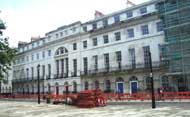
Looking along the southern terrace of Fitzroy Square - No. 33 at one end and No. 40 at the other

Front elevation of 40 Fitzroy Square, the
former London Skin Hospital, now the
Advanced Hair Studio
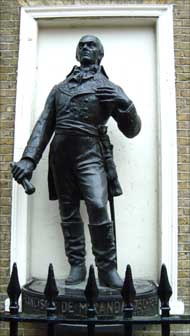
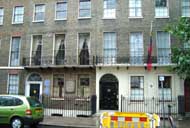 The Venezuelan Consulate in Grafton Way. Miranda House, the
Venezuelan Cultural Centre is next door and bears commemorative plaques
to de Miranda and Bello, two patriots.
The Venezuelan Consulate in Grafton Way. Miranda House, the
Venezuelan Cultural Centre is next door and bears commemorative plaques
to de Miranda and Bello, two patriots.
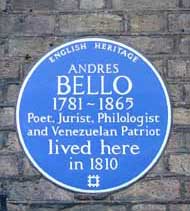
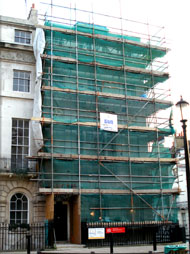
Front elevation of 33 Fitzroy Square currently under bandages
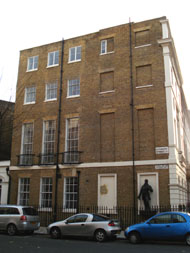
Side elevation of 40 Fitzroy Square, with a statue commemorating Francisco de Miranda, the Venezuelan revolutionary, who lived at 58 Grafton Way from 1802-1810
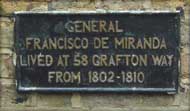
The statue was installed in 1990 at the request of the Ambassador of Venezuela
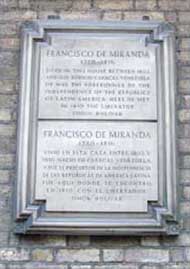
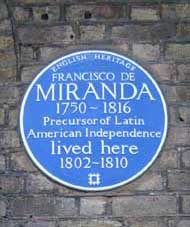
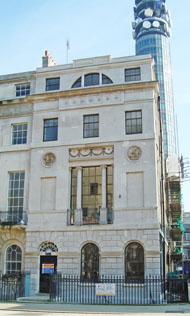
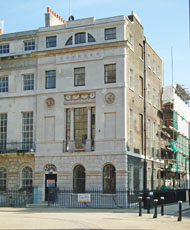

Black N 2006 Walking London's Medical History. London, Royal Society of Medicine Press.
Dagnall JC 1980 London Foot Hospital modernization. British Journal of Chiropody 47: 130-131.
Dagnall JC 1988 The London Foot Hospital. British Journal of Chiropody 53: 185-199
http://collage.cityoflondon.gov.uk (1)
http://collage.cityoflondon.gov.uk (2)
www.british-history.ac.uk
www.camdennewjournal.co.uk
www.feetforlife.org
www.geograph.org.uk
www.guardian.co.uk
www.guardian.co.uk/education
www.pastscape.org.uk
Return to home page